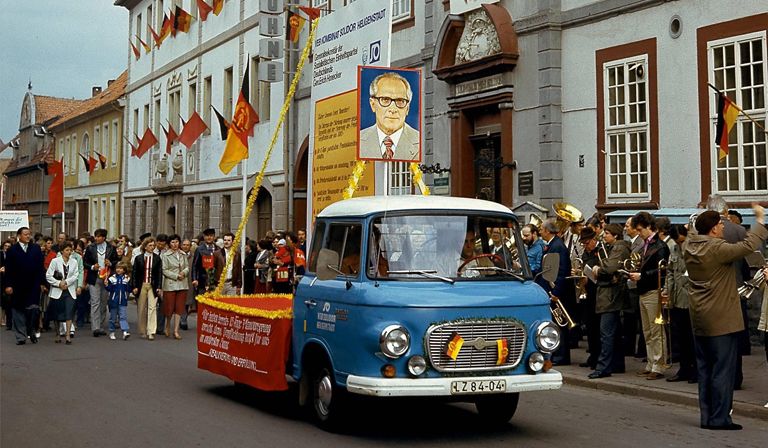There once was a country in the middle of Europe with a population of 16m. It covered more than 40,000 square miles and boasted about a dozen significant cities. It had its own parliament, anthem and flag—a mix of black, red and gold, with a roundel in the middle. Like many countries, it endured and perpetrated horrors, but also had moments of glory or just of normalcy.
And then, one day, a little more than 30 years ago, the country vanished.
That country was East Germany—or the German Democratic Republic (GDR), if you’d prefer to use the official name. It existed for four decades, from 1949 to 1990, and many people will remember the circumstances of its reunification with West Germany to make the bigger country we know today. The piece-by-piece destruction of the Berlin Wall, which actually took place a year before the formal dissolution of the GDR, is a conspicuous punctuation mark in the history of the 20th century.
And yet, despite the fierce clarity of those memories, the country itself has rather been forgotten, or lost within the broader history of the Soviet Union and its fall. There was the wall, yes. There was the Stasi, the GDR’s secret police force, with its horrible methods of surveillance. But what else?
Until the publication of Katja Hoyer’s Beyond the Wall this April, there hadn’t been a single-volume, English-language history of the country—and scarcely any German-language ones—with which the ignorant, such as I, could repair the gaps in their knowledge.
“I think one of the main points is to write the history of East Germany, rather than of the communist world. I think there’s a very distinct and unique story there,” Hoyer tells me in a café attached to London’s Charing Cross station. She is a visting research fellow at King’s College London, so we decided to meet halfway between the university and the Prospect offices. This is her second book—and it is superior, even, to her first, Blood and Iron, which spanned the birth of the German Empire in 1871 to its demise in 1918.
“I wanted to get rid of the idea that the GDR was a grey country where people spent 40 years waiting for their liberation and did practically nothing else,” she continues. “A lot of stuff happened! By 1990, this was a third of the entire time that Germany had existed as a nation state. Yet we tend to treat it as a solid block. One of my main aims was to complicate and colour in this period of German history—because, otherwise, I think you virtually take away the stories of millions of people in Europe.”
Who are these people? Well, because all this happened not too long ago, many of them are still alive; some are well known. Hoyer begins Beyond the Wall with the example of one Angela Merkel—chancellor of Germany from 2005 to 2021, of course, and among the most significant world leaders of the 21st century. Merkel’s family moved to the GDR when she was a few months old and she grew up to become a research scientist, remaining there until reunification. “Many people don’t even know that she was East German,” observes Hoyer. “If they do, it’s mentioned almost as trivia: like, did you know that she’s afraid of dogs? Yet this was half of her life, and it has shaped her as the person she is.”
The situation clearly pressed on Merkel during her political career. She was encouraged to keep her past in the past while chancellor—and mostly did so—though she allowed it to erupt into the present as her leadership came to an end. In an episode from October 2021, recounted in Beyond the Wall, Merkel decided to speak as, in her words, “a citizen from the East, as one of more than 16m people who lived a life in the GDR”. She complained that it was “as if this life before German reunification didn’t really count… no matter what good and bad experiences one had”.
Lumping together Nazi Germany and East Germany is a form of scholarly oversight
“That she can only find it in herself to say that when she’s on the brink of leaving the public stage, I found it quite remarkable,” says Hoyer. “It’s almost like she had to get this off her chest.”
But Merkel’s experience is not hers alone. As the book goes on to emphasise, there are the other 16m. This number includes political figures such as Walter Ulbricht, the communist true believer who perhaps did more than anyone to build the GDR in the image of Stalin’s USSR after the Second World War, and Erich Honecker, the youth leader who became overall leader for 20 years. But it also includes soldiers, plumbers, lecturers, farmers, chemical engineers—and Hoyer’s parents, as well as Hoyer herself.
“I wrote this book as a historian—and that’s something I really want to make clear. This isn’t a personal story of the GDR,” she explains. “But the reason I chose this topic in the first place is quite personal.” Hoyer was born in the GDR in 1985, “in a town named after the first and only president of the Republic”. Her mother studied in Dresden at the time, in order to become a teacher. Her father was an officer in the air force. They led, she says, a “normal life”, although “they also encountered a lot of the more repressive aspects of the regime”.
In a way, and although the first-person doesn’t invade the text, this makes Beyond the Wall an exercise in self-understanding: “I have some memories—they are a child’s memories—but I’ve always wondered what it would have been like if I had been born 10, 15, 20 years earlier. What would I have made of the state?”
In particular, Hoyer’s reveries take her back to one moment in GDR history. At a publishing dinner, a few days before our coffee meeting, she used a four-minute speaking slot to describe the energy and potential of the 10th World Festival of Youth and Students that was held in the eastern portion of Berlin in 1973. I press her on this: what’s so special about that get-together of young people from communist countries?
“What I was trying to capture was the idea that 1973 was, in many ways, a moment when things could have gone a different way,” she says. “Control from the Soviet Union was being reduced. East Germany was becoming more confident as its own state. Honecker had recently come in [as general secretary of the Socialist Unity Party of Germany, and therefore as leader of the GDR] and he knew that there were an awful lot of very idealistic young people who wanted socialism, but they also wanted a democratic form of socialism. They wanted some degree of market economy.”
“That little window of time is interesting to me. I wonder: if I had been a young person in the GDR, would I have appreciated that debate? Would I have wanted to take part in it? Or would I have been part of the machine?”
This exercise in self-understanding is really an act of wider understanding. It is a process that requires empathy; a way of understanding those who wanted democratic progress in the GDR, but also those who didn’t, as well as those who couldn’t have cared less. Beyond the Wall demonstrates that sort of empathy in spades. The same cannot be said of our collective memory, which reduces the GDR to a forgettable grey mass—“like something that you experienced as a person, and you’re trying to tell yourself that it was just an unfortunate episode, it isn’t part of who you are”—or else associates it with a blacker period in history.
“Now, quite often, we use this phrase ‘German dictatorships’ in the plural,” Hoyer points out. But lumping together Nazi Germany and East Germany is, she thinks, a form of scholarly oversight: “I think one of the key differences is that Nazi Germany was all-pervasive, it entered every aspect of your life, whereas in the GDR you could live a private life, so long as you didn’t put your head above the parapet… And then, of course, there wasn’t the genocide. As obvious as that sounds, it’s often forgotten in the way the two systems are compared.”
Lest it need saying, Beyond the Wall is not an apologist work. In her effort to define the amorphous contours of the GDR, Hoyer does indeed draw attention to the everyday happiness that some people achieved within its borders; to the flowering of Ostrock, a uniquely German variety of pop music; to the hugely successful aid-for-trade programme involving Vietnamese coffee plantations. “I don’t think that these more positive aspects even came into the narrative after the Cold War,” she says. “I don’t think there was a conscious effort to repress them; I just think it never occurred to West Germans, who tend to dominate the debate, that there might have been a positive angle at all.”
But neither does Hoyer ignore the atrocities of the Stasi and the broader state. Beyond the Wall is a book of—to invert Merkel’s phrase—“bad and good experiences”. It contains accounts of torture and control; of purges and persecution; of how the early potential of the Honecker regime and the 1973 World Festival spluttered and collapsed, leaving many of the same ills and iniquities as before.
Many of its primary sources are the dark fruits of a rotten system. “People trusted me with their private Stasi files, which is such a personal thing to do,” reveals Hoyer. By accessing these files in the years after the wall fell, East Germans would find out who spied on them—“It could literally be their colleague, or neighbour, or spouse.” The information inside could range from the relatively harmless (“how often a person went to drink in their local bar”) to the rather less so (“whether they had extramarital relationships”).
* * *
The reason I wanted to interview Hoyer—apart from the fact that she has now authored two tremendous books—is that, seemingly from nowhere, the GDR is currently percolating throughout the culture (see box-out). One of my favourite television shows of last year was the German-made and Netflix-backed Kleo, the story of a former Stasi assassin getting revenge on her deposed handlers. And now, in 2023, the sehr cool publisher Fitzcarraldo has released While We Were Dreaming, the tale of a group of Leipzig-living teens during reunification, written by the Leipzig-based novelist Clemens Meyer, who was also a teenager during reunification; while Penguin has added a significant work by another East German author, Siblings by Brigitte Reimann, to its famous Classics line.
I hesitate to ask Hoyer about this, in case she thinks I’m casting her book—the first of its kind, after all—as part of a nebulous trend. But instead she addresses my half-finished question with enthusiastic vigour: “I mean, I could have written this book in a decade’s time… so why now?” Could it be because Russia’s invasion of Ukraine has reminded us all that Europe is not a fixed entity? “I think there’s something to that; although, of course, I started researching and writing before the invasion happened. Obviously, there’s been a big question over eastern Europe for a while now: where does it fit in with western Europe?”
Or perhaps the reasons are more generational? “There’s this generation of people, like me, who grew up with a vague memory of the GDR, but they don’t have any experience of the hostility and aggravation that existed during the Cold War. Maybe now there’s a chance to talk about these things. Had I tried to publish the very same book in, say, the late 1990s, I imagine it would have been shot down. It would have been too raw, too emotional.”
In any case, it’s not only the culture that’s tuning into the GDR—British politicians are too. In a speech from July 2021, ahead of the collapse of his own regime, Boris Johnson compared the government’s “levelling up” agenda with German reunification. “It is an astonishing fact,” he stated, “that… the per capita GDP of the northeast of our country… is now lower than in what was formerly East Germany… to a large extent, Germany has succeeded in levelling up where we have not”. Proving that this is not just a Conservative talking point, the Labour mayor of Greater Manchester, Andy Burnham, has, on numerous occasions, cited the “long-term support and investment” received by East Germany since “the fall of communism”.
Hoyer is dismissive. “I don’t think it’s a particularly useful comparison,” she says. “What’s happened with the north and south of England is a longstanding issue, much longer than 40 years. It’s structural and cultural. Whereas the dividing line between east and west Germany was quite artificial. They ended up being treated differently, politically and economically, for 40 years, but that’s easier, politically and economically, to undo. The north-south divide in Germany is perhaps a more apt comparison—because that actually is a historical divide.”
Not for the first time, then, our leaders need a history lesson. We all do. “Erich Honecker was in charge of a significant country in the middle of Europe for 20 years,” finishes Hoyer. “But I bet that if you step out of here now, walk down the Strand and ask people about Honecker, they wouldn’t know. And yet he had a huge impact not just on German history but also on European history.”
And, with that, the interview is over—but not my task. With Hoyer’s words in mind, I walk not down the Strand but in the opposite direction, along Whitehall, to ask people whether they have heard of Honecker. I pick on those who look as though they work in politics, suited and efficient. Two, out of about 30 or 40, answer in the affirmative. Perhaps that ratio will now improve with the welcome publication of Beyond the Wall.
















